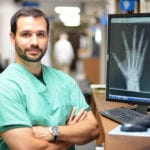A Study of NCAA Football Elbow Injuries

As Dr. Donnelly discussed in his blog post on Football Hand Injuries, football is a demanding sport that puts athletes at risk for a variety of injuries. A recent study of football elbow injuries spanning five years provides insights into injuries among National Collegiate Athletic Association (NCAA) football players, helping to highlight trends and preventative measures. Dr. Donnelly is not only an orthopedic surgeon specializing in the hand, wrist, and elbow but has served as a sideline physician for high school and college football teams. He has witnessed firsthand how these injuries can occur on the field. In today's post, learn why it's important to have a football elbow injury evaluated by a specialist.
Elbow Injury Rates in NCAA Football
Elbow injuries, while less common than other types of sports injuries, occur at a notable rate of 1.892 injuries per 10,000 athlete exposures (AEs) among NCAA football players. This statistic underlines the physical demands of football, where even less frequent injuries can significantly impact player health and team performance.
When and Where Do Most Injuries Happen?
The majority of elbow injuries happen during actual games rather than practices, with the injury rate during competitions nearly eight times higher than during practice sessions. This discrepancy likely reflects the higher intensity and aggressive physical engagements that are more common in the competitive environment of a game.
Common Types of Elbow Injuries
The study found that acute instability issues like dislocations and ligament strains are the most frequent elbow injuries. These injuries typically result from direct impacts or falls that occur during the rough and tumble of a football game. Understanding these common injuries can help in developing targeted prevention and treatment strategies.
Recovery and Impact on Play
Most elbow injuries thankfully result in less than 24 hours of missed play, suggesting that they are often minor. However, in more severe cases, players may face extended downtime or require surgical interventions. This variability underscores the importance of prompt and effective medical attention to manage the severity and recovery time of elbow injuries effectively.
Seasonal Variation in Injury Rates
Injury rates do not differ much between the preseason and the regular season, but both are higher than in the postseason. This pattern may relate to players' varying levels of conditioning across the season and the strategic adjustments teams make as they advance towards more crucial games.
This study not only sheds light on the specific risks associated with elbow injuries in college football but also underscores the importance of prevention strategies and immediate care to minimize impact on players’ health and game readiness. As fans and supporters of NCAA football, understanding these aspects helps in appreciating the physical challenges athletes face and the critical role of sports health professionals.
Why Seeing a Specialist Matters
About Dr. Brandon P. Donnelly, MD
 Dr. Brandon P. Donnelly is a board certified hand surgeon with Pontchartrain Orthopedics & Sports Medicine. Dr. Donnelly completed his hand and microsurgery fellowship at the prestigious Philadelphia Hand to Shoulder Center. Dr. Donnelly treats all ages of patients in the greater New Orleans area for hand, wrist, and elbow conditions.
Dr. Brandon P. Donnelly is a board certified hand surgeon with Pontchartrain Orthopedics & Sports Medicine. Dr. Donnelly completed his hand and microsurgery fellowship at the prestigious Philadelphia Hand to Shoulder Center. Dr. Donnelly treats all ages of patients in the greater New Orleans area for hand, wrist, and elbow conditions. 
